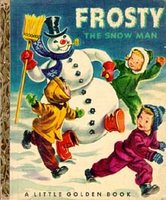Notes on Early Animated Christmas Specials
 You may be familiar with the 1969 Rankin/Bass holiday special Frosty the Snowman (produced by the same lead director and producer of the 1964 Rudolph the Red-Nosed Reindeer and many other holiday specials). What many people don't know is that this wasn't the first animated version to hit television.
You may be familiar with the 1969 Rankin/Bass holiday special Frosty the Snowman (produced by the same lead director and producer of the 1964 Rudolph the Red-Nosed Reindeer and many other holiday specials). What many people don't know is that this wasn't the first animated version to hit television.
The 1950s were an interesting time in television animation. Walt Disney was the strongest force in the industry and there was no competing with the levels of realism that his techniques had achieved. Other animators were beginning to wonder if Disney's obsession with heightened realism were limiting animation, and explored more "cartoonish" styles. In 1951, United Productions of America had their first success with Gerald McBoing-Boing, an adaptation of an adaptation - a story by Dr. Seuss that had been made into a record already in 1950. It's the story (in Seussian rhyme, of course) of a boy who speaks in sound effects instead of words.
Another record that came out in 1950 was the first recorded version of "Frosty the Snowman," by Gene Autrey. He had already had a big success with "Rudolph the Red-Nosed Reindeer" and "Here Comes Santa Claus" in an era when songwriters, fresh from writing love songs for WWII soldiers and their honeys back home, were finding that there was a big market for new, secular holiday music. The genre had pretty much been invented by Irving Berlin with "White Christmas" 1940 and several songs had been big seasonal successes throughout the war years thanks to the soldiers on the front who were missing their families and communities in the USA. My grandmother still tells the story of how my grandfather wrote her the lyrics from the record "I'll Be Home For Christmas" in a winter letter in 1943, and how she had gotten so excited that she didn't read the last line - "If only in my dreams" - and was devastated when she realized he wasn't coming home yet. The miracle of Christmas, as far as 1950s Hollywood was concerned, was its proof that American pop culture was capable of producing media products that crossed over between adults and children, or, rather, that adults could be made to consume products designed for children.
UPA went on to produce a "music video" for "Frosty the Snowman" in 1954. It's a lot of fun to watch if you have seen the Rankin/Bass version too many times, of which I have never been a big fan. [Via] I get tired of cartoons aimed at little kids which always seem to have to have a villain and major drama. Children have the natural capacity to appreciate the same kind of subtle tension and drama that adults enjoy - the issues and concerns are just different, and thus the sources of drama must be different. But young children are also happy experiencing things which are not plotted in the same conflict/resolution format as stories produced for adults.
I get tired of cartoons aimed at little kids which always seem to have to have a villain and major drama. Children have the natural capacity to appreciate the same kind of subtle tension and drama that adults enjoy - the issues and concerns are just different, and thus the sources of drama must be different. But young children are also happy experiencing things which are not plotted in the same conflict/resolution format as stories produced for adults.
This is one of the reason I've never been a huge fan of the 1960s' Frosty. But I also personally get tired of their animation style very fast; I think their stop-motion work in Rudolph and other animated specials has held up much better. The form is reminiscent to me of old cereal box characters, which look great on cereal boxes but there I don't have to stare at them for half an hour at a time. There is something that is way too basic about them to hold my interest, and the plots are usually wholly consistent with that simplicity.  It took Chuck Jones to help usher in a new level of artistry in holiday movies that showcased a signature style with an intensity and subtlety that a cereal box can't encompass. From How the Grinch Stole Christmas to the amazing Raggedy Ann and Andy Great Christmas Caper (Brother-and-sister rag dolls vs. Wile E. Coyote? Have I died and gone to heaven?) Compare the Grinch and Professor Hinkle. Could you just see Professor Hinckle and Hocus Pocus shilling for some wheatieo cereal with marshmallow top hats?
It took Chuck Jones to help usher in a new level of artistry in holiday movies that showcased a signature style with an intensity and subtlety that a cereal box can't encompass. From How the Grinch Stole Christmas to the amazing Raggedy Ann and Andy Great Christmas Caper (Brother-and-sister rag dolls vs. Wile E. Coyote? Have I died and gone to heaven?) Compare the Grinch and Professor Hinkle. Could you just see Professor Hinckle and Hocus Pocus shilling for some wheatieo cereal with marshmallow top hats?
 The Snowman is a perfect example of the kinds of story young kids can enjoy following. Where's the villain there? Where's the conflict? For young children, adventures can often be encompassed by exploring a new idea or vision. When the vision has been explored, the adventure ends. It's my daughter's holiday favorite for the year, for sure. (Click here to visit her blog.) I will show her the 1954 Frosty the Snowman on this blog, but that's plenty for this year - I'll wait a few more years before inflicting the Rankin/Bass version on myself.
The Snowman is a perfect example of the kinds of story young kids can enjoy following. Where's the villain there? Where's the conflict? For young children, adventures can often be encompassed by exploring a new idea or vision. When the vision has been explored, the adventure ends. It's my daughter's holiday favorite for the year, for sure. (Click here to visit her blog.) I will show her the 1954 Frosty the Snowman on this blog, but that's plenty for this year - I'll wait a few more years before inflicting the Rankin/Bass version on myself.







1 comment:
I think Gerald McBoingboing now works for Garrison Kiellor's Prairie Home Companion.
Post a Comment